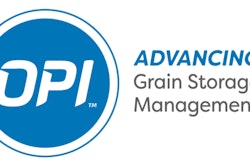Four years ago, Calgary, AB-based OPIsystems Inc. launched OPI-integris to introduce the U.S. market to a novel grain management approach that has been widely adopted throughout the world for more than 25 years. The company’s mantra is “be proactive, not reactive” with respect to grain conditioning.
Utilizing a myriad of grain temperature and moisture monitoring components, OPI-integris claims to deliver the highest return on grain investments with its Advanced Grain Management solution, called IntegrisPro.
The three-part system consists of:
- Sensing inputs of temperature cables, moisture cables, and insect detectors, as well as headspace, plenum, outside relative humidity and temperature sensors, with data constantly read, then related back to the controller.
- Integration with automated fan, heater and other conditioning equipment controls.
- Customer Care Program, which provides ongoing software updates and help desk access with options for extended warranty and annual site maintenance.
Aeration application
Since its U.S. debut, the system has been successful in on-farm moisture control applications, and in smaller commercial operations with in-bin drying systems. But can the three prongs work together to provide return on investment for large commercial grain handlers and grain elevators?
“It can be applied to any type of bulk storage, but there is a caveat,” explains OPI-integris CEO Dave Crompton. “There are different levels of control that can be achieved based on your storage parameter. In commercial storage, the tanks are very large with grain depths that can exceed 100 feet. In that case, it’s impossible to push enough air through the grain mass to significantly change moisture content, so all you can do is control the temperature so as to maintain moisture content and grain quality.”
In grain handling terms, aeration is the practice of controlling the temperature of stored commodity. Ideally conditioned grain is achieved when the grain mass reaches its commodity-specific target temperature with the least amount of variance within the bin. Wide temperature variance can result in moisture migration, leading to condensation and development of localized high-moisture zones and potential grain spoilage.
Effective aeration requires a host of equipment and devices, such as aeration ducts, fans, roof vents, temperature cables and fan controllers. Many options are available in the marketplace, so selecting the right equipment can be a challenge without guidance. Crompton says OPI-integris’ Customer Care Program and its unique software allow it to help customers select appropriately sized aeration equipment.
“IntegrisPro helps to get the best benefits from the aeration equipment, and with Integris ProModel, we can help to identify the type and size of equipment required to achieve the target objective,” says Crompton.
IntegrisPro works using Remote Terminal Units (RTUs) to capture data and output fan and roof ventilation controls using wired and/or wireless communication back to an IntegrisPro software-configured PC. Integris ProModel’s ability to read, understand and use the data is crucial to its ability to effectively manage the aeration controls.
“Components are important, but if you don’t have the right knowledge or control algorithms and integration of a modeling program to help achieve the target objective, the components likely will not be able to do their job,” explains Crompton. “With Integris ProModel, we can analyze your specific conditions and make complex calculations to decide when and how long to run all the conditioning equipment, so as to achieve the targets in the most cost- and time-effective manner.”
The Customer Care Program provides ongoing software updates and management experts to work with employees on training and periodic retraining due to turnover.
Customer Care
The third prong in OPI-integris’ Advanced Grain Management solution is its Customer Care Program. All electronic or computer-controlled operation systems come with the inherent risk of failure, not to mention an initial learning curve for users. That’s why IntegrisPro customers have access to OPI-integris’ Customer Care Program for a nominal annual fee to help educate customers and assure the system is achieving positive results with maximum facility uptime. Tech support and remote support is also available for troubleshooting and fixing system problems, as well as site maintenance.
“We describe our Customer Care Program as a partnership,” says Crompton. “We take a long-term approach that starts on the front end with the IntegrisPro support that lasts through the sales cycle and on the tail end through the extended Customer Care Program. We go beyond the components themselves and assist with the functionality of the operation over the long term.”
The ongoing software updates include new developments of grain variety-specific EMC curves and control strategy improvements as they are incorporated into the system, which helps deliver return on investment over the long term.
Return on investment
There are two significant ways that the Advanced Grain Management solution’s aeration controls can provide ROI for commercial operations: energy savings and shrink control.
“We can save upwards of 80% on fan fan run-time,” says Crompton. “People tend to ‘air’ on the safe side with manual fan operation, so they typically run the fans more than needed, thus wasting electricity. When you run the fans too much, you get hit with a double whammy. You’re wasting electricity, but you’re also creating shrink.”
Shrink describes the devaluation of grain by removing excess moisture, thus reducing its weight and market price. The goal during storage is to achieve the right balance of moisture content to get maximum market value without any conditioning problems. Managing shrink is particularly valuable for grain elevators and commercial operations that handle higher volumes of grain because even a slight improvement can have significant financial rewards on that large a scale.
“It’s realistic to get a total return on investment on this technology in two years or less because we can achieve a 1% improvement in moisture control in one year. So if you’ve got a million bushels of grain, 1% improvement on corn at $7/bushel will reap $70,000 — about the cost of the IntegrisPro investment.”
Crompton adds that once the cost is recovered, the technology will continue to accrue benefits for another 10 or 20 years.
Controlling the temperature of stored grain leads to higher quality, less shrink, increased storability, grain deterioration prevention, reduced storage loss, and ultimately, higher profits. Although automated fan controls are not a novel concept, the heightened level of data capturing and utilization of information to help users make important management decisions is what sets OPI-integris apart. Improving its Advanced Grain Management solution will continue to be the company’s main objective and commitment to its customers.

















